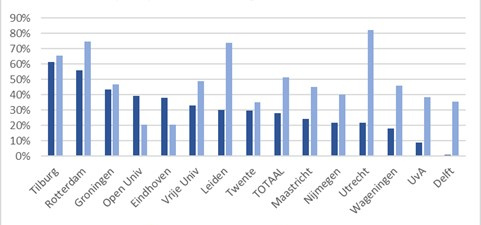OCW uses 37-year-old data for university budgets
The financing of the universities is partly based on data from 1984, admits outgoing minister Van Engelshoven in a letter to the House of Representatives. She blames the universities.

Picture: Type tank
Do universities get enough money for their work? And how do we actually know that? The funding of university education is partly based on a 1984 study, noticed the Court of Audit this spring.
That is research from 37 years ago. At the time, employees were asked to keep track of what they spent their time on ('time recording'). In 2001 the conclusion was drawn from this that 34,9 percent of the funding was intended for education.
In that year, the government budget for the universities was split into an education component and a research component. The education part grew with the student numbers, but the research part did not.
1984
The Court of Auditors expressed strong criticism last June. Would a 1984 estimation still apply to work at today's universities? The House of Representatives was also surprised and wanted a response from the minister.
The cabinet response is short and to the point. Indeed, the 1984 data still feeds into university funding, but it was the only source available at the time and the universities did not want to repeat the research.
Data from 1984 does indeed still affect university funding, but it was the only available source at the time
Moreover, the skewed growth of the budget has long been acknowledged, the minister adds. According to her letter, an additional 600 million euros per year is needed. 'A subsequent government can take a decision on this', writes Van Engelshoven, 'just like on the desirability of having a new time-writing study carried out.'
Why did the universities not want to repeat the research at the time? This type of research takes place in the personal sphere of employees and then it is important in what kind of 'climate' it takes place, says the umbrella association VSNU in a response. In other words, you have to have faith in such research.
Changed
That climate seems to have changed. Nothing has been decided yet, but the universities are already exploring how they can carefully examine the time use of their employees, “now that it has also been recognized by politicians in The Hague that there are structural shortages in wo and the workload of employees is far too high. is”.
However, according to the VSNU, 1984 is certainly not the last time that researchers mapped out the activities of employees at the university. The spokesperson provides a list of recent publications about, among other things, time use, work pressure and well-being of employees. You don't have to do new time writing research to know that the universities are short of money, they believe.
Incidentally, the universities want more money than the 600 million euros, they mention an amount of 1,1 billion euros
Incidentally, the universities want more money than the 600 million euros mentioned by the minister. For that amount, the minister refers to an analysis by consultancy firm PwC Strategy&. That 600 million is needed for structural financing and for catching up, it says. But it says more: smaller-scale education would cost another 200 million euros per year on top of that, so that would bring you to 800 million.
The universities themselves mention an amount of 1,1 billion euros. They also include a one-off expenditure of 300 million euros for the improvement of the facilities.


